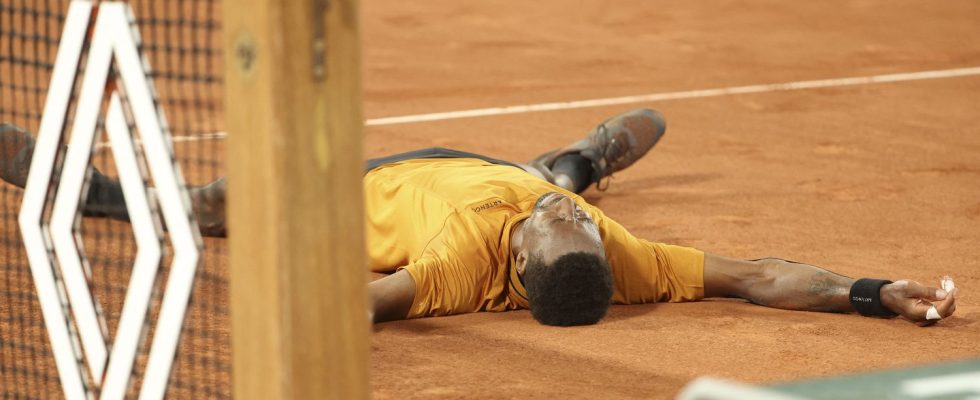During their career, tennis players have to deal with recurring pain that they have to manage in the short and long term.
“We can say that we make movies from time to time, but there, frankly, it hurts!“, whispered Gaël Monfils, mockingly, in a press conference, Tuesday, May 31, after having ejected Sebastian Baez from the first round of Roland-Garros after an epic fight ended after midnight on one leg, and limping with difficulty between each point. Eventually the injury got the better of him.Hit in the left wrist, the Habs went to the end of himself, but he will not go further, forced to forfeit against Holger Rune.
Pain, this permanent enemy
Former 135th player in the world, Alizé Lim remembers. “I’ve played with huge rips before. Once even, I evolved on the court with a torn ligament in the foot all under 35°C in the sun.“A case reminiscent of that of Serbian Novak Djokovic who won the Australian Open in 2021 with an abdominal tear throughout the fortnight.
The first Major of the year has sometimes been the site of medical miracles. Coordinator of physical training within the French Tennis Federation, Paul Quétin witnessed a strange turnaround in 2021 in Melbourne. “I remember Gilles Simon at the Australian Open. He hurt his ankle just before the tournament and he walks around the player lounge on crutches. Everyone thinks he’s going to forfeit and he beats Marin Cilic in five sets in the second round.” 48 hours earlier, the Frenchman had already released Daniel Brands after 4:32 of play.
“I’m with Nicolas Mahut when he plays against John Isner at Wimbledon. On the third day he gets up and can’t move. He comes to training and tells me he can’t play. He had body aches incredible abs. We trained without serving and when he got on the court he served normally for three hours.”
Paul Quétin, physical trainer at the FFTat franceinfo: sport
Currently ranked 426th in the WTA, Marine Partaud sums up the daily life of a high-level tennis player. “We seek our limits every day. You push your body into extreme situations.” To manage pain, the mind is the first ally. In training, for lack of the adrenaline of the match, players push the mind to become accustomed to pain. “As a physical trainer, I cannot ignore this mental dimension. We sometimes flirt with overtraining. I remember very long bike rides to create an extreme fatigue effort without hurting them to allow them to push their limits while maintaining control.“explains Paul Quétin.
The human behind the machine
But the mind has its limits, as learned the hard way Marine Partaud. “I had a world championship in Mexico with the France team so I couldn’t say no and I had wanted to play too much, traces the native of Poitiers. I took three months of injury.“Prevention has become vital. Before every practice, no player avoids mobility exercises, massage rollers and other stretches. During matches, the straps are also like a second skin for most. The forearms of Gaël Monfils can testify to this.
“I remember the Davis Cup in Moscow in 2007. Marat Safin can’t play on Friday. He comes to see us and shows us his hands. They were bleeding, he had cracks everywhere. On Sunday, Russia is mistreated. Safin came out of the hat, his hands bandaged everywhere and he played incredible tennis to put three small sets to Paul-Henri Mathieu.
Paul Quétin, physical trainer at the FFTat franceinfo: sport
But when prevention is no longer enough, analgesics and anti-inflammatories take over. Sometimes excessively. “Anti-inflammatories are a solution because it makes us grow wings and we tell ourselves that we will be able to play normally again right away but it can mask the pain“, explains Alizé Lim.
Infiltrations are also used. But since January 2022, the infiltrations of glucocorticoids are now supervised by the World Anti-Doping Agency (WADA) to prevent abuse and are considered TUEsauthorizations for use for therapeutic purposes.
The question of health
These methods are also not without risk in the long term. For a career that will last for the strongest over fifteen years at the professional level, the consequences on the physical level are multiple. Florent Serra and Thierry Tulasne had hip surgery after their careers. If Andy Murray did not wait to undergo the same operation and make an interesting return to the world circuit (he is now 43rd at the ATP), he had to forfeit Roland-Garros.
“At the moment, my foot hurts, I have a piece of cartilage that is gone. I can’t serve for eight months“, blows Alizé Lim. While Marine Partaud, she fears the future. “There are mornings when I wake up and I feel like I’m 96. Sometimes I tell myself that at 50, I might be in a wheelchair because I would have strained my joints.“
